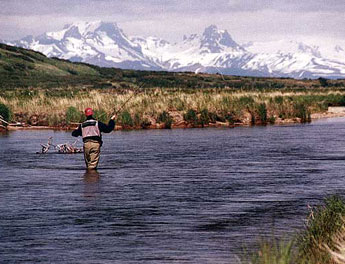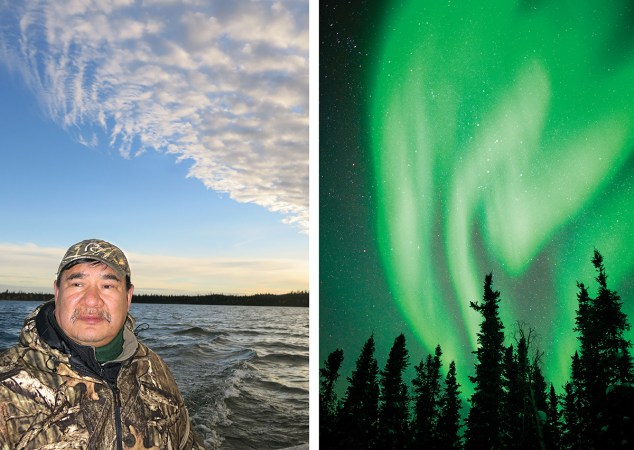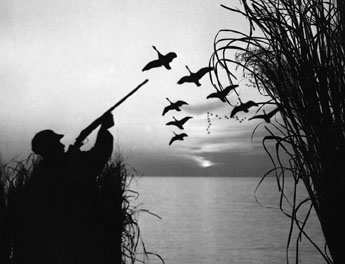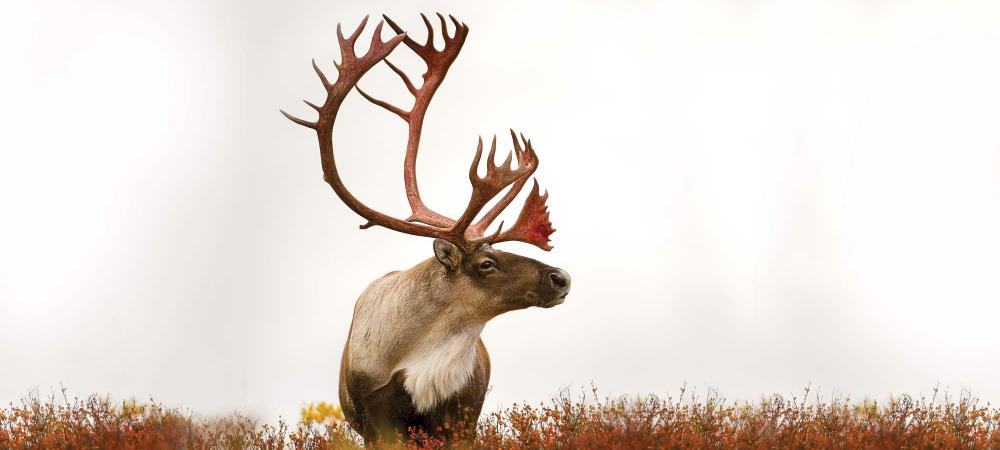To a sportsman, Canada can be whatever you want it to be. Looking for a budget trout trip? Float an Ontario river for copper-bright brookies. Want to blow your bonus on a trophy whitetail hunt? Book with an Alberta outfitter. You can spend more than $6,000 on a guided Arctic Circle expedition for musk ox or polar bear, or a couple hundred bucks on a do-it-yourself prairie waterfowl hunt. Fly in or drive, splurge or skimp, test your physical limits or kick back.
If you’ve been considering a Canada trip, now is the time to cinch down the details. Here are a handful of destinations and opportunities to consider in the Northland. Some require a thick bankroll, others only a tank of gas and a good canoe. Take your pick.
SASKATCHEWAN South Saskatchewan River Snow geese, Canada geese, specklebelly geese, sandhill cranes Cost: $ Exertion: 2
There’s no calm in the eye of a snow-goose cyclone. Only awe, and a frenzied attempt to reload your shotgun. You can experience thousands of geese dropping into your decoys almost any October morning on the pea fields along the South Saskatchewan River.
Snow, specklebelly and Canada geese, as well as sandhill cranes, come off the river into stubble fields, and decoying can be so consistent you don’t need an outfitter. Access is fairly open here. Just pick up a Rural Municipality map that details land ownership and knock on a lot of doors.
Pack as many shell and flag decoys as you can carry. A couple dozen dekes won’t cut it when flocks number in the thousands. Generally, the snow goose action is better to the west, along the Alberta border, centered out of Leader. The honker and speck shooting is better east toward Elbow.
Last year the Saskatchewan goose limit was 8 dark geese and 20 white geese, plus 5 cranes, daily. The nonresident game bird license costs $116, and you also have to buy a $19 federal permit. The first week of October is prime.
NEWFOUNDLAND Humber River Atlantic salmon, sea-run brook trout Cost: $$$ Exertion: 2
The Canadian government spawned controversy when it shut down commercial netting of Atlantic salmon off the Newfoundland coast in 1991, but the result has been the renaissance of the Humber River’s sport fishery. While Atlantic salmon remain an endangered species south of the border, up here they’re in relatively good shape.
Sixty percent of all Atlantic salmon in North America return to Newfoundland rivers, and the Humber leads the province in salmon production. This is the river that angling legend Lee Wulff said “has to be visited at least once in every salmon angler’s life.” Come here in late June and in July for high catch rates of 4- to 7-pound keeper grilse (as smaller salmon are called here) as well as sea-run brook trout to 3 pounds. Bigger salmon run from late July through early October. These salmon range from 20 to 35 pounds. Some monstrous Atlantic salmon tip the scales at over 40.
All fishing is done with fly gear, and bushy dry flies take a good percentage of Humber salmon. The local favorite is the Orange Bomber, which looks like “a cigarette butt with hackle spun around it,” according to guide Bill Bryden at Eureka Outdoors in Corner Brook, Newfoundland (866-272-5666). In the big-fish section near the mouth of the river, Bryden recommends anglers pack at least 200 yards of backing on their fly reels lest they’re spooled by some wide-shouldered rocket. Farther upstream, the river’s shoals are conducive to wade-fishing, and Bryden offers dozens of lakes where brookies can be fished with spinners and bait.
You must have a guide to fish the Humber. Most package trips start at about $2,700 (U.S.) for a week.
QUEBEC George River Caribou Herd Woodland caribou Cost: $$$$ Exertion: 3
The world’s largest caribou herd isn’t in Alaska or the Yukon. It roams the muskeg barrens and stunted forests of northern Quebec and Labrador. The George River herd numbers approximately 750,000, and the herd at Leaf River contributes another 430,000.
Once the herds begin their southern migration in early August, the entire landscape appears to be a moving quilt of hides and antlers. The best hunting for these woodland caribou is through October along migration routes.
You’ll need an outfitter, mainly to get you to the remote caribou camps along the Quebec/Labrador border northwest of Goose Bay, Labrador. A guide is useful, but the main hunting strategy is to get in the way of the epic migration of this huge herd, then wait for the right bull, or “stag” as they’re called here, to walk past. The limit is two stags, and since caribou sport the largest antlers in proportion to body size of any big-game animal in the world, most hunters are tickled to shoot a mature bull.
Hunting trophies requires a little more work. Book an outfitter equipped to boat the confusion of freshwater lakes and rivers and put you in position. Once you select a worthy bull, stalk through the tundra to get within range.
Most hunters fly to Montreal, then take a regional flight to either Goose Bay or Schefferville, where they meet their host and begin a long drive or flight to camp. Expect to pay from $3,000 to more than $4,000 (U.S.) for a week-long guided hunt, which often includes black bear and ptarmigan along with lake trout and char.
ONTARIO Algonquin Provincial Park Brook trout, walleyes, smallmouth bass, lake trout Cost: $ Exertion: 2-4
A day’s drive north of Buffalo or northeast of Detroit puts you in the heart of the North Woods brook trout district. You can drive Highway 60 through the southern end of Algonquin Provincial Park, but to get the most out of this maze of rivers and glacial lakes, bring a canoe and traverse the interior of the 4,800-square-mile park, more than twice the size of the state of Delaware.
The park features 1,500 kilometers (about 1,000 miles) of designated canoe routes, many of which thread through lakes and flowages that hold brookies, lake trout, smallmouth bass, walleyes and muskellunge. The best way to enjoy the park is to rent a restored backwoods ranger cabin, which will cost anywhere from about $31 per night to about $400 per week (U.S.). You can also stay in developed campgrounds along Highway 60, but be sure you book sites well in advance, as this is a popular weekend destination for Ontario families. To make reservations for campsites or cabin rentals, call 1-888-668-7275 or Algonquin Park Information (705-633-5572).
Brook trout are the target species in most of the park. Fish average 16 inches, with trophies hitting 5 pounds. Bright spinners and spoons and small crankbaits work well, as do worms and salmon eggs. Fly anglers drift terrestrial imitations such as Parachute Hoppers and Black Ants and strip big streamers in rapids to catch bigger brookies.
MANITOBA AND ONTARIO Lake of the Woods Walleyes, muskellunge, pike, smallmouth bass, crappies Cost: $$ Exertion: 1
You could stay at a different lodge every week on Lake of the Woods and spend 10 years meeting new hosts. There are that many backwoods fish camps and full-service lodges on both the Minnesota and Canadian shores of the huge lake. The reason for the abundance of concessionaires is twofold: The lake is close enough to Midwestern population centers that outfitters do a steady business in budget-minded, drive-up vacationers; and the fishing for muskies, northern pike, walleyes and smallmouth bass is consistent enough to justify all that traffic.
In fact, the fishing can be so good that lodges don’t have to offer top-notch amenities to stay in business, so Lake of the Woods has more than its share of underwhelming accommodations.
You can skip a land-based lodge altogether and rent a houseboat. Lake of the Woods has so many remote coves and big-bay weed beds you can fish a different spot each day and stand a good chance of catching something. If you don’t, simply weigh anchor and move. Ontario Wilderness Houseboat Rental (www.wildernesshouseboats.com or 800-359-6199) in Morson, Ontario, provides a fleet of houseboats. It also rents 16-foot outboards you can tow behind the mother ship, then cast off and take to whichever shallow coves and points you want to fish. Rates range from $1,000 (U.S.) for four nights aboard a 44-footer that sleeps five to $3,100 (U.S.) for a week on a 64-footer with 11 beds.
The best months to fish Lake of the Woods are May and September, but you can catch fish even at the height of summer, though you might have to go deeper and cover more water for your limit. Bring standard walleye tackle, a variety of big crankbaits, spinnerbaits and topwaters for pike and muskie and a selection of plastics and jigs for bass and crappies. The lake is a loafing spot for a variety of southbound ducks, so if you’re here in October, bring decoys and shoot ducks before your day of fishing.
THE NORTHWEST TERRITORIES/NUNAVUT Victoria Island Greenland musk oxen, island caribou, lake trout, arctic char Cost: $$$$$ Exertion: 4
The galvanized grain bins out on the tundra don’t store soybeans or corn. They’re bunkhouses, meant to keep polar and grizzly bears from fussing with caribou and musk-ox hunters. The best hunting for both species is from the 60th parallel north to the Arctic Circle in both the Northwest Territories and the Nunavut district. The window for caribou hunting is short–about three weeks starting in mid-August. Musk-ox hunting is best in late August by boat and again in March for snowmobile and dog-sled hunters.
The established outfitters operate from fly-in lakes along the caribou migration routes. Some, such as High Arctic Lodge on Victoria Island in the Nunavut region, also offer island caribou hunting. Surprisingly, the featureless Arctic tundra teems with wildlife–from wolves and arctic foxes to arctic hares and ptarmigan.
Musk oxen on Victoria Island number about 50,000. Hunters generally tag out in the first two days, says High Arctic’s Fred Hamilton (800-661-3880, www.higharctic.com). That leaves time for three days of lake trout and arctic char fishing at the scores of lakes within float-plane distance of the lodge. Hamilton’s 2004 rate for a 4- or 5-day hunt starts at around $5,300 (U.S.).
SASKATCHEWAN Lake Athabasca Lake trout, northern pike, grayling, whitefish Cost: $$$$ Exertion: 2
Great Slave Lake, in the Northwest Territories, has a reputation for giant lake trout, and prices for outfitted trips to match. For fish of a similar caliber at more reasonable rates, fly to northern Saskatchewan’s Lake Athabasca, where you can catch giant lakers and northern pike for a week.
Go in July for lakers in the 30-pound class and pike that consistently top 20 pounds. Bonus opportunities include walleyes, arctic grayling and whitefish, but Lake Athabasca’s big sulphur-and-caramel-colored lake trout are its finest trophies.
Casting spinners and spoons accounts for most big fish; trolling is also productive. Topwaters, spinnerbaits and crankbaits take the best pike, says lodge owner Cordell Sihlis of Lakers Unlimited (780-662-3513). The lodge’s lake trout record stands at a massive 55 pounds; the biggest pike taken from the lake weighed 31 pounds.
Expect to pay between $2,200 and $2,400 (U.S.) for a week-long trip, which includes air transportation from and to Edmonton, Alberta.
ALBERTA Edmonton Whitetail deer, mule deer Cost: $$$$ Exertion: 2
The reigning world-record typical whitetail might hail from Saskatchewan, but trophy deer hunters figure the next number-one will come from Alberta from somewhere within a hundred-mile radius of Edmonton.
High-quality forage, plenty of timbered cover and limited hunting pressure make this region prime big-buck territory. Just don’t expect to find one on your own. Most of this land is leased to outfitters who savor–and profit from–their province’s reputation.
Hunting styles vary, but this is primarily a sit-down hunt. Rattling late-season bucks is popular, but if you don’t want to endure a Rocky Mountain November on the ground, look for outfitters that offer heated tower blinds overlooking clearings and fields. Contact Ongaro Outdoor Outfitters (800-465-6227, www.ongaros.com) or McKenzie Brothers Outfitting (780-987-7300, www.mckenzieoutfitting.com) for details.
Transporting Firearms
If you plan to bring your own gun on a Canada trip–and who doesn’t?–expect to complete some paperwork and to pay for the privilege.
Canada’s firearms laws are onerous enough for residents, who must register their guns with the government. But visitors must also declare their firearms when they enter the country. It’s a good idea to take care of this detail long before your trip by completing the government’s Non-Resident Firearm Declaration form, which you can download from the Internet by visiting the Canada Firearms Centre (www.cfc-cafc.gc.ca) and selecting the “Visitors to Canada” menu. You can also call the center (800-731-4000) to request one. Present the completed form to the customs agent when you enter the country, pay a $50 fee (about $38 U.S.–no cash or checks), and you should be on your way.
Don’t try to bring a handgun with a barrel shorter than 4 1/4 inches, any fully automatic shotgun or rifle or any long gun with a barrel shorter than 18 inches or with an overall length shorter than 26 inches. In fact, it’s a good idea to leave any handgun at home; handguns cause more border scrutiny than they’re worth.
The form allows you to transport the gun, buy ammunition and take the gun back into the States on your return. You must also meet some transportation requirements, including making the gun inoperable (either by removing its bolt or attaching a gun lock), keeping the gun in a locked container and storing ammunition in a separate container while in transit.
If your destination is defined as a “remote wilderness area,” you may keep your firearm “handy and unlocked” but unloaded, according to the country’s gun rules.
Bringing Home the Bacon You shouldn’t have problems bringing either game meat or your trophies home. You can check out a list of ports of entry at www.le.fws.gov/Contact_Info_Ports.htm. If you’re flying, inquire about meat and antler rules before you leave. Air Canada will accept cleaned and well-covered antlers as checked luggage for a $100 (U.S.) surcharge. All meat must be transported in leakproof containers. Go to www.aircanada.ca/services/luggage/checked.html for updates. For U.S. rules go to www.aphis.usda.gov/lpa/issues/bse/bse.html or call APHIS’s National Center for Import and Export at 301-734-3277.
BRITISH COLUMBIA Bella Coola Grizzly bears, black bears, timber wolves, mountain goats, chinook and silver salmon, halibut, lingcod Cost: $$$$ Exertion: 4
British Columbia has a wider array of species than any other province, but what makes the diversity astonishing is their proximity to each other. It’s possible to bag a coastal wolf at dawn, stalk an alpine mountain goat by noon and finish the day winching up triple-digit halibut from the Queen Charlotte Strait.
A few outfitters specialize in clustering these opportunities in package deals. With Bella Coola Outfitting Co. (604-946-0640, www.bcoutfitting.com), you bunk and dine aboard a 75-foot converted commercial trawler and make hunting and fishing forays on 16-foot outboards. The accommodations allow anglers to fish lingcod, red snapper and halibut with little effort, and to spot grizzly and black bears, blacktail deer and wolves from the water. Packages range from $1,600 to $2,000 (U.S.).
British Columbia is perhaps the top trophy-goat destination on the continent, with good numbers of 9- and 10-inch billies. Plus, the coastal rivers are full of salmon and steelhead. After hiking 4,000 feet straight uphill for a goat, fighting a 25-pound king can seem downright relaxing.
BRITISH COLUMBIA Babine River Steelhead Cost: $$$$ Exertion: 3
You’d think the world’s greatest steelhead river would be stingy with its contents, but British Columbia’s Babine River can be remarkably generous. In fact, the hardest thing about fishing the river is the problem of getting to it. With no roads leading there, the Babine is the domain of fly-in lodges.
Once you’ve arrived, catch rates are high on trophy-sized steelhead, especially in the upper 20 miles of river, accessible only by jet boats. Most anglers flyfish, and 20-pound steelhead are common during the high season from mid-September through October. The record-class fish break 30 pounds, with at least a few fish over 35 pounds each season, according to Chick Stewart at Babine Steelhead Lodge (250-577-3108, www.fishbabine.com).
All this solitude and success comes at a price. Week-long guided trips start at about $3,625 (U.S.) per person.








